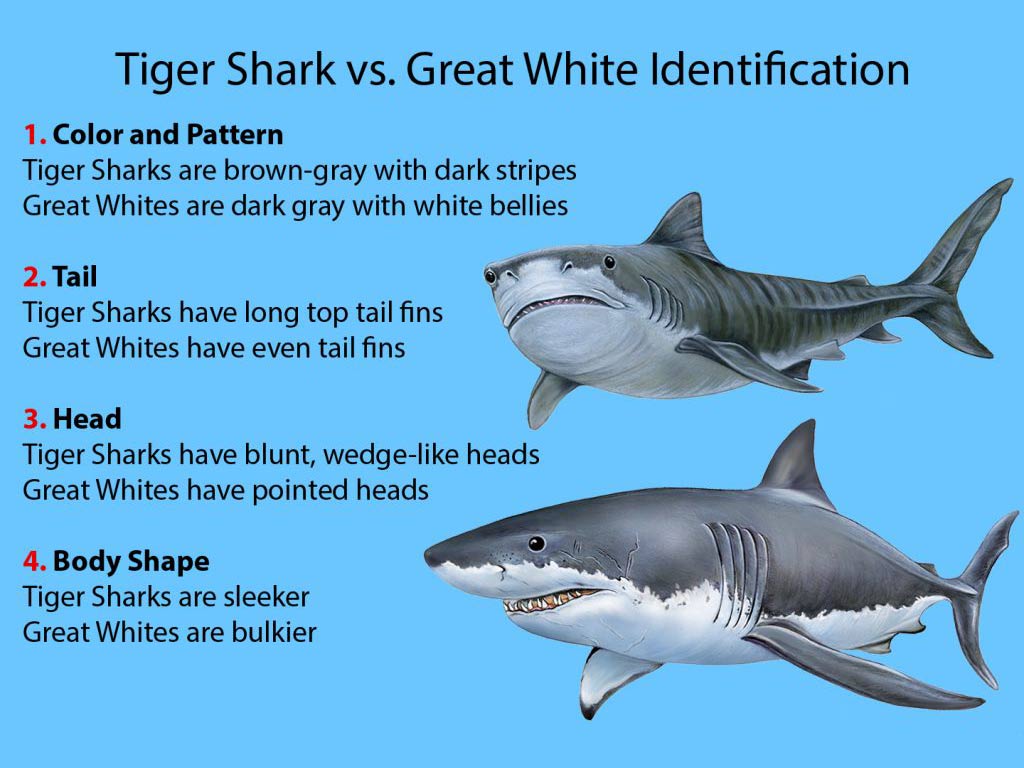Introduction
When it comes to apex predators of the ocean, two names often come to mind – the Tiger Shark and the Great White Shark. Both are formidable creatures, commanding respect and fascination from marine enthusiasts and researchers alike. In this blog, we’ll delve into the distinctive characteristics, behaviors, and habitats of these magnificent creatures, offering a comparative analysis that sheds light on the unique aspects of the Tiger Shark and the Great White Shark.
I. Anatomy and Physical Features
A. Tiger Shark
The Tiger Shark (Galeocerdo cuvier) earns its name from the distinctive dark vertical stripes that resemble a tiger’s pattern. This species boasts a robust, fusiform body, allowing it to navigate through various marine environments. Its blunt snout and serrated teeth make it well-adapted for a diverse diet.
B. Great White Shark
The Great White Shark (Carcharodon carcharias) is instantly recognizable due to its powerful build and iconic coloration – a grayish-blue back that blends with the ocean depths and a stark white underbelly. Known for its conical snout and large, serrated teeth, the Great White is a swift and agile predator.
II. Size and Weight
A. Tiger Shark
Tiger Sharks are known for their impressive size, with some individuals reaching lengths of over 16 feet. They are among the larger shark species, and their weight can range from 850 to 1,400 pounds.
B. Great White Shark
The Great White Shark, however, takes the crown for size among predatory sharks. It can grow even larger than the Tiger Shark, with some specimens exceeding 20 feet in length and weighing over 5,000 pounds.

III. Geographic Distribution
A. Tiger Shark
Tiger Sharks are highly adaptable and can be found in a wide range of environments. They are commonly spotted in tropical and subtropical waters, making appearances in coastal areas, bays, and even the open ocean.
B. Great White Shark
Great White Sharks are distributed across the globe, favoring cooler waters near coastlines. They are often associated with regions such as South Africa, Australia, California, and the Mediterranean.
IV. Feeding Habits
A. Tiger Shark
Tiger Sharks are renowned for their omnivorous diet. Their eclectic palate includes fish, seals, birds, and even carrion. Their strong jaws and teeth enable them to crack the shells of sea turtles and crustaceans.
B. Great White Shark
Great White Sharks are formidable carnivores, primarily feeding on seals, sea lions, and fish. They are known for their spectacular breaches while hunting seals near the water’s surface.
V. Behavior and Interaction with Humans
A. Tiger Shark
Tiger Sharks are generally considered less aggressive towards humans compared to some other shark species. However, their inquisitive nature and scavenging tendencies can lead to occasional encounters.
B. Great White Shark
Great White Sharks have a reputation as fearsome predators, fueled by their role in popular culture. While attacks on humans are rare, their predatory behavior and powerful image contribute to their mystique.
FAQs
Are Tiger Sharks More Aggressive Than Great Whites?
Explore the nuances of aggression in these species and understand the factors that contribute to their behavior.
Can Tiger Sharks And Great Whites Interbreed?
Dive into the science behind interbreeding, discovering whether these two magnificent species can create hybrids.
What Is The Average Lifespan Of These Sharks?
Unlock the mysteries of their lifespan, from the early years to the later stages of these apex predators’ lives.
How Deep Can These Sharks Dive?
Plunge into the depths as we explore the incredible diving abilities of tiger sharks and great whites.
Do They Migrate, And If So, Why?
Follow the migratory patterns of these oceanic giants, understanding the reasons behind their journeys across vast expanses of water.
Are There Any Recorded Shark-Human Conflicts?
Separate fact from fiction as we delve into recorded instances of shark-human conflicts and explore the reasons behind such encounters.
Conclusion
In the ultimate showdown of the ocean, the Tiger Shark and the Great White Shark each bring their unique strengths and adaptations to the table. While the Tiger Shark excels in adaptability and a diverse diet, the Great White Shark reigns supreme in sheer size and power. Understanding these distinctions is crucial for fostering a greater appreciation and coexistence with these incredible creatures.






